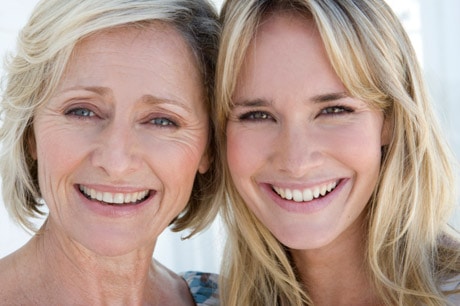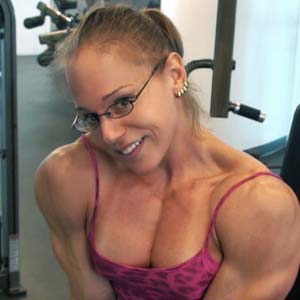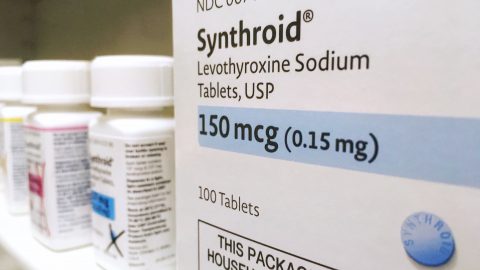EDITORS NOTE: A recent video I (Will Brink) did HERE also discusses the fact T is just as important women as it is for men, yet continues to be ignored by most women and the medical community at large. Monica’s excellent article below give the full details!
Testosterone is popularly known as the “male” hormone. While it is true that men have much higher levels of testosterone than women, and that testosterone contributes to secondary sex characteristics that physiologically distinguish men from women (increased muscle mass and facial/body hair), this does not mean that testosterone isn’t important in women.
In the same way that men need estrogen, aka the “female” hormone, for optimal health, women need testosterone for optimal health. This article will describe testosterone physiology in women and its importance for women’s health, and refute the two prevailing myths that “testosterone is un-physiological in women”, and that “there is no research or clinical experience supporting the use of testosterone therapy in women”…. you may be surprised…!
History behind common beliefs of testosterone in women
In the past, circulating testosterone in women was simply considered to be a by-product of ovarian estrogen production. Surprisingly, testosterone circulates in the blood stream in levels exceeding those of estradiol (the major estrogen) by 200-fold (see below), and it is thus the most abundant biologically active hormone in women. In fact, testosterone in measured in ng (nanogram) while estradiol is measured in pg (picogram) units (1 nanogram = 1000 picograms).
This simple fact refutes the old notion that testosterone is “foreign” or un-physiological in the female body. Despite this, a long-held belief is that androgen administration to women is “anti-physiologic”.[1] This myth primarily underpins the fear of the use of testosterone therapy for women today [2], and probably contributed to making estrogen the hormone of choice for “replacement therapy” in women.
Testosterone production and levels in women
In women testosterone is produced and secreted by the adrenals (25%) and the ovaries (25%), each approximately 50 mcg per day, with the remaining 50% being produced in peripheral cells from circulating DHEA and androstenedione.[3-6]
Total daily testosterone production rate in women is in the order of 0.1–0.8 mg [3, 7] while in men it is around 6.9 mg/d.[7] The table below shows reference ranges for testosterone in women, measured by mass spectrometry (the golden-standard hormone assay that has accuracy even at low steroid hormone levels).
Table 1: Age-specific testosterone reference ranges in women.[8]
| Age (years) | Total Testosteroneng/dL |
| 20–29 30–3940–4950–5960–6970–80 |
12 – 63 11 – 5911–5810 – 569 – 548 – 52 |
Now, compare these numbers with the reference ranges for estradiol (also measure by mass spectrometry): [9]
* Pre-menopausal women in follicular, mid-cycle, and luteal phases of cycle:
2.4 pg/mL, 3.1 pg/mL and 2.6 pg/mL, respectively;
* Post menopausal women: 0.5 pg/mL
As the numbers shows, the highest estradiol reference number for a cycling woman is 3.1 pg/mL or 310 pg/dL or 0.31 ng/dL (note the differences in measurement units). As indicated in the table, testosterone reference ranges span from 8 to 63 ng/dL. Thus in women, natural testosterone levels are 25 to 200 times higher than estradiol! Tell this to anybody who claims that testosterone is un-physiological in women!
Contrary to estradiol, as the table shows, there is no sudden drop in testosterone levels in women with natural menopause.[10, 11] The largest decrease in testosterone levels in women occurs the early reproductive years, with no change across the menopausal years (ages 45–54).[10] It should be noted that even after natural menopause, the postmenopausal ovary is hormonally active, contributing significantly to the circulating pool of testosterone.[12] This is in contrast to the abrupt 20-50% drop in testosterone levels in women who undergo surgical removal of both ovaries (bi-lateral oophorectomy, more on that below).[10, 13-16]
In premenopausal women testosterone is at its lowest concentrations in the early follicular phase of the cycle (after menstrual flow has ended) and rises to a mid-cycle peak.[17] As in men, women have a circadian fluctuation in sex hormone levels, with testosterone levels being highest in the morning around 8am.[18] In both pre- and postmenopausal women testosterone levels are significantly lower 3pm when compared to 8am. In premenopausal women, the same circadian fluctuation is seen for estradiol (the main estrogen).[18]
In regards to reference ranges, the fluctuations in testosterone levels during the menstrual cycle and during the day are relatively small compared with the overall inter-individual variability, so reference ranges can be applied in general irrespective of the day in the menstrual cycle the blood draw was taken and its timing.[19] However, it should be remembered that reference ranges are just a reference and not an indication of an optimal level for an individual for strive for (which displays a significantly inter-individual variability). Because of inter-individual differences in androgen receptor sensitivity (which is seen in both men and women), [20-27] changes in testosterone levels (both relative and absolute) over time are more informative in predicting outcomes than actual levels.[28] Therefore, is advisable to do regular blood draws at around the same clock time, so that deviations (increases or decreases) can be reliably monitored. This applies to both men and women.
Physiological importance of testosterone in women
Evidence that testosterone is of physiological importance in women and potentially plays important roles in multiple organ systems and female physiology comes from the fact that in human tissues (both male and females) there is a wide distribution of androgen receptors throughout the body. Studies have indentified significant androgen receptor expression in both male and female non-reproductive tissues, including the brain, skeletal muscle, breast, bone, kidney, thyroid, colon, lung and adrenal glands.[29-33] There is also significant expression of the androgen receptor in female reproductive tissues including endometrium, ovary, uterus, fallopian tube and myometrium.[29, 34-36]
Further indications that testosterone is important for women’s health comes from studies showing that bilateral oophorectomy (surgical removal of both ovaries) is associated with higher risk of coronary heart disease, stroke, osteoporosis, Parkinson’s, dementia, cognitive impairment, depression and anxiety, and overall mortality. [37-43] While it has been suggested that this is due to estrogen deficiency (when performed in young women), its long-term negative consequence on heart disease risk factors is not completely ameliorated by estrogen use.[44] The observation that women with oophorectomy are at greater risk for heart disease than intact women points to testosterone deficiency as a major contributing factor rather estradiol deficiency.[45]
Further evidence on the importance of testosterone in women comes from studies that have given women estrogen therapy after removal of the ovaries. One study found that pre-menopausal women who underwent oophorectomy experienced a significant worsening of vasomotor symptoms (hot flashes, night sweats and sweating) and a decline in sexual functioning (desire, pleasure, discomfort and habit).[46] The increase in vasomotor symptoms and the decline in sexual functioning were mitigated by post-surgery estrogen replacement therapy, but symptoms did not return to pre-surgical levels.[46] Another study in post-menopausal women also found that the negative effect of oophorectomy cannot be corrected by estrogen replacement therapy.[47] Thus, estrogen alone cannot make up for the consequences of the drop in testosterone that follows removal of the ovaries. Studies of both the consequences of oophorectomy and the effects of testosterone replacement are consistent with an important role for androgens in female sexual function, well-being and health.[48] In an upcoming article I will cover other causes of testosterone deficiency in women.
History of use of testosterone therapy in women

Few people know that testosterone therapy was reported to effectively treat symptoms of the menopause as early as 1937.[49] In 1938 studies demonstrated that testosterone therapy effectively treats various gynecological and sexual disorders.[50, 51] The actions of testosterone propionate on the uterus and breast was actually reported in the first volume of the highly acclaimed medical journal The Lancet in 1938.[51]
1941 the beneficial effects of testosterone in ameliorating various gynecological disorders in women were further documented in a study of women in different gynecological groups.[52] It was found that testosterone therapy effectively alleviates dysmenorrhea, after-pains, premenstrual tension and breast pain, dysfunctional uterine bleeding, and menopausal symptoms.[52] Interestingly, the study author states “The use of androgenic hormones for the relief of varied functional gynecologic disorders has now been thoroughly accepted.”[52] That same year it was shown that androgens are synthesized in the female and are the precursors of estrogen biosynthesis.[53]
1943 it was suggested that testosterone nullify or modify the action of estrogens, suppress or decrease the production of estrogens by the ovary and inhibit proliferation in the endometrium.[54] It was further reported that testosterone is effective in treating premenstrual tension and breast pain, dysmenorrhea (pain during menstruation that interferes with daily activities), postpartum engorgement of the breasts (painful overfilling of the breasts with milk), menometrorrhagia (prolonged or excessive uterine bleeding that occurs irregularly and more frequently than normal), and certain types of the menopause syndrome.[54]
Several studies published in the 1940s confirmed that testosterone increases women’s sexual libido.[54-56]
One of these studies specifically reported the following general effects:[55]
(a) Enlargement of the clitoris. No patient found this to be unpleasant.
(b) Increased sexual drive even in older women. The fact that this can be found without a single exception, even when the male hormone is given by injections in sufficient amounts, shows that testosterone can be designated as an “infallible aphrodisiac”.
c) All testosterone treated women acknowledge a great feeling of wellbeing, more balanced moods, and clearer thinking; and some profess also a greater determination.
In regards to the psychological effects, the study author amusingly reported “…we might therefore speak of a “chemistry of the emotions” in order to express that the temperament is influenced by the chemical substance so long as the hormone is active. It would be interesting to go further into this side of hormone therapy, and to study how the feelings might be chemically controlled. Some of Freud’s theses would perhaps have to be modified.”[55] Later is was confirmed that physiological doses of testosterone may be used to advantage in the management of the menopause, sexual dysfunction and breast disease.[1] Thus, the myth that “there is no research or clinical experience supporting the use of testosterone therapy in women” is clearly false. In upcoming articles I will report on more recent studies on testosterone therapy in women of all ages.
Conclusion
Contrary to common belief, testosterone levels in women are naturally higher than estradiol by some 200-fold, and are thus not un-physiological for women. The ovaries in women of all ages are a significant source of testosterone. Even the postmenopausal ovary is an ongoing site of testosterone production, although the production of estradiol ceases.
Little known, testosterone therapy has been clinically used since the 1940s to treat menstrual problems, sexual dysfunction, and menopausal symptoms. Studies on women who have had their ovaries surgically removed further clearly show the importance of testosterone for women’s health and wellbeing.
In upcoming articles I will report and comment on recent studies of testosterone therapy in women of all ages, and its beneficial as well as potential side-effects. Stay tuned!
References:
1. Greenblatt, R.B., The use of androgens in the menopause and other gynecic disorders. Obstet Gynecol Clin North Am, 1987. 14(1): p. 251-68.
2. Davis, S.R., Androgen therapy in women, beyond libido. Climacteric, 2013. 16 Suppl 1: p. 18-24.
3. Longcope, C., Adrenal and gonadal androgen secretion in normal females. Clin Endocrinol Metab, 1986. 15(2): p. 213-28.
4. Labrie, F., et al., Endocrine and intracrine sources of androgens in women: inhibition of breast cancer and other roles of androgens and their precursor dehydroepiandrosterone. Endocr Rev, 2003. 24(2): p. 152-82.
5. Labrie, F., Intracrinology. Mol Cell Endocrinol, 1991. 78(3): p. C113-8.
6. Labrie, F., et al., Physiological changes in dehydroepiandrosterone are not reflected by serum levels of active androgens and estrogens but of their metabolites: intracrinology. J Clin Endocrinol Metab, 1997. 82(8): p. 2403-9.
7. Horton, R., J. Shinsako, and P.H. Forsham, Testosterone Production and Metabolic Clearance Rates with Volumes of Distribution in Normal Adult Men and Women. Acta Endocrinol (Copenh), 1965. 48: p. 446-58.
8. Haring, R., et al., Age-specific reference ranges for serum testosterone and androstenedione concentrations in women measured by liquid chromatography-tandem mass spectrometry. J Clin Endocrinol Metab, 2012. 97(2): p. 408-15.
9. Ray, J.A., et al., Direct measurement of free estradiol in human serum by equilibrium dialysis-liquid chromatography-tandem mass spectrometry and reference intervals of free estradiol in women. Clin Chim Acta, 2012. 413(11-12): p. 1008-14.
10. Davison, S.L., et al., Androgen levels in adult females: changes with age, menopause, and oophorectomy. J Clin Endocrinol Metab, 2005. 90(7): p. 3847-53.
11. Burger, H.G., et al., A prospective longitudinal study of serum testosterone, dehydroepiandrosterone sulfate, and sex hormone-binding globulin levels through the menopause transition. J Clin Endocrinol Metab, 2000. 85(8): p. 2832-8.
12. Fogle, R.H., et al., Ovarian androgen production in postmenopausal women. J Clin Endocrinol Metab, 2007. 92(8): p. 3040-3.
13. Judd, H.L., et al., Endocrine function of the postmenopausal ovary: concentration of androgens and estrogens in ovarian and peripheral vein blood. J Clin Endocrinol Metab, 1974. 39(6): p. 1020-4.
14. Judd, H.L., W.E. Lucas, and S.S. Yen, Effect of oophorectomy on circulating testosterone and androstenedione levels in patients with endometrial cancer. Am J Obstet Gynecol, 1974. 118(6): p. 793-8.
15. Havelock, J.C., et al., The post-menopausal ovary displays a unique pattern of steroidogenic enzyme expression. Hum Reprod, 2006. 21(1): p. 309-17.
16. Hughes, C.L., Jr., L.L. Wall, and W.T. Creasman, Reproductive hormone levels in gynecologic oncology patients undergoing surgical castration after spontaneous menopause. Gynecol Oncol, 1991. 40(1): p. 42-5.
17. Abraham, G.E., Ovarian and adrenal contribution to peripheral androgens during the menstrual cycle. J Clin Endocrinol Metab, 1974. 39(2): p. 340-6.
18. Panico, S., et al., Diurnal variation of testosterone and estradiol: a source of bias in comparative studies on breast cancer. J Endocrinol Invest, 1990. 13(5): p. 423-6.
19. Braunstein, G.D., et al., Testosterone reference ranges in normally cycling healthy premenopausal women. J Sex Med, 2011. 8(10): p. 2924-34.
20. Westberg, L., et al., Polymorphisms of the androgen receptor gene and the estrogen receptor beta gene are associated with androgen levels in women. J Clin Endocrinol Metab, 2001. 86(6): p. 2562-8.
21. Sawaya, M.E. and A.R. Shalita, Androgen receptor polymorphisms (CAG repeat lengths) in androgenetic alopecia, hirsutism, and acne. J Cutan Med Surg, 1998. 3(1): p. 9-15.
22. Crabbe, P., et al., Part of the interindividual variation in serum testosterone levels in healthy men reflects differences in androgen sensitivity and feedback set point: contribution of the androgen receptor polyglutamine tract polymorphism. J Clin Endocrinol Metab, 2007. 92(9): p. 3604-10.
23. Lapauw, B., et al., Is the effect of testosterone on body composition modulated by the androgen receptor gene CAG repeat polymorphism in elderly men? Eur J Endocrinol, 2007. 156(3): p. 395-401.
24. Liu, C.C., et al., The impact of androgen receptor CAG repeat polymorphism on andropausal symptoms in different serum testosterone levels. J Sex Med, 2012. 9(9): p. 2429-37.
25. Stanworth, R.D., et al., Dyslipidaemia is associated with testosterone, oestradiol and androgen receptor CAG repeat polymorphism in men with type 2 diabetes. Clin Endocrinol (Oxf), 2011. 74(5): p. 624-30.
26. Campbell, B.C., et al., Androgen receptor CAG repeats and body composition among Ariaal men. Int J Androl, 2009. 32(2): p. 140-8.
27. Simanainen, U., et al., Length of the human androgen receptor glutamine tract determines androgen sensitivity in vivo. Mol Cell Endocrinol, 2011. 342(1-2): p. 81-6.
28. Holm, A.C., et al., Change in testosterone concentrations over time is a better predictor than the actual concentrations for symptoms of late onset hypogonadism. Aging Male, 2011. 14(4): p. 249-56.
29. Wilson, C.M. and M.J. McPhaul, A and B forms of the androgen receptor are expressed in a variety of human tissues. Mol Cell Endocrinol, 1996. 120(1): p. 51-7.
30. McEwen, B.S., Neural gonadal steroid actions. Science, 1981. 211(4488): p. 1303-11.
31. Colvard, D.S., et al., Identification of androgen receptors in normal human osteoblast-like cells. Proc Natl Acad Sci U S A, 1989. 86(3): p. 854-7.
32. Notelovitz, M., Androgen effects on bone and muscle. Fertil Steril, 2002. 77 Suppl 4: p. S34-41.
33. Willoughby, D.S. and L. Taylor, Effects of sequential bouts of resistance exercise on androgen receptor expression. Med Sci Sports Exerc, 2004. 36(9): p. 1499-506.
34. Chadha, S., et al., Androgen receptor expression in human ovarian and uterine tissue of long-term androgen-treated transsexual women. Hum Pathol, 1994. 25(11): p. 1198-204.
35. Chang, C., et al., Androgen receptor (AR) physiological roles in male and female reproductive systems: lessons learned from AR-knockout mice lacking AR in selective cells. Biol Reprod, 2013. 89(1): p. 21.
36. Traish, A.M., et al., Role of androgens in female genital sexual arousal: receptor expression, structure, and function. Fertil Steril, 2002. 77 Suppl 4: p. S11-8.
37. Parker, W.H., et al., Ovarian conservation at the time of hysterectomy for benign disease. Clin Obstet Gynecol, 2007. 50(2): p. 354-61.
38. Parker, W.H., et al., Effect of bilateral oophorectomy on women’s long-term health. Womens Health (Lond Engl), 2009. 5(5): p. 565-76.
39. Jacoby, V.L., et al., Oophorectomy vs ovarian conservation with hysterectomy: cardiovascular disease, hip fracture, and cancer in the Women’s Health Initiative Observational Study. Arch Intern Med, 2011. 171(8): p. 760-8.
40. Hickey, M., M. Ambekar, and I. Hammond, Should the ovaries be removed or retained at the time of hysterectomy for benign disease? Hum Reprod Update, 2010. 16(2): p. 131-41.
41. Erekson, E.A., D.K. Martin, and E.S. Ratner, Oophorectomy: the debate between ovarian conservation and elective oophorectomy. Menopause, 2013. 20(1): p. 110-4.
42. Shuster, L.T., et al., Prophylactic oophorectomy in premenopausal women and long-term health. Menopause Int, 2008. 14(3): p. 111-6.
43. Rivera, C.M., et al., Increased cardiovascular mortality after early bilateral oophorectomy. Menopause, 2009. 16(1): p. 15-23.
44. Kritz-Silverstein, D., E. Barrett-Connor, and D.L. Wingard, Hysterectomy, oophorectomy, and heart disease risk factors in older women. Am J Public Health, 1997. 87(4): p. 676-80.
45. Barrett-Connor, E., Menopause, atherosclerosis, and coronary artery disease. Curr Opin Pharmacol, 2013. 13(2): p. 186-91.
46. Finch, A., et al., The impact of prophylactic salpingo-oophorectomy on menopausal symptoms and sexual function in women who carry a BRCA mutation. Gynecol Oncol, 2011. 121(1): p. 163-8.
47. Celik, H., et al., The effect of hysterectomy and bilaterally salpingo-oophorectomy on sexual function in post-menopausal women. Maturitas, 2008. 61(4): p. 358-63.
48. Shifren, J.L., Androgen deficiency in the oophorectomized woman. Fertil Steril, 2002. 77 Suppl 4: p. S60-2.
49. Salmon, U.J., Effect of testosterone propionate upon gonadotropic hormone excretion and vaginal smears of human female castrate. . Exp Biol Med (Maywood), 1937. 37(3): p. 488–91.
50. Shorr, E., ., G.N. Papanicolaou, and B.F. Stimmel, Neutralization of ovarian follicular hormone in women by simultaneous administration of male sex hormone. Proc Soc Exp Bio Med, 1938. 38: p. 759–62.
51. Loeser, A.A., The action of testosterone propionate on the uterus and breast. Lancet Infect Dis, 1938. 1: p. 373–4.
52. Berlind, M., Oral administration of methyl testosterone in gynecology. J Clin Endocrinol Metab, 1941: p. 986–91.
53. Salmon, U.J., Rational for androgen therapy in gynecology. J Clin Endocrinol, 1941. 1: p. 162–79.
54. Salmon, U.J. and S.H. Geist, Effect of androgens upon libido in women. J Clin Endocrinol, 1943. 3: p. 235–8.
55. Loeser, A.A., Subcutaneous Implantation of Female and Male Hormone in Tablet Form in Women. Br Med J, 1940. 1(4133): p. 479-82.
56. Greenblatt, R.B., F. Mortara, and R. Torpin, Sexual libido in the female. Am J Obstet Gynecol 1942. 44: p. 658–63.







